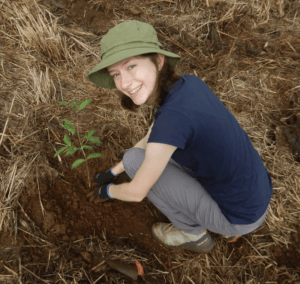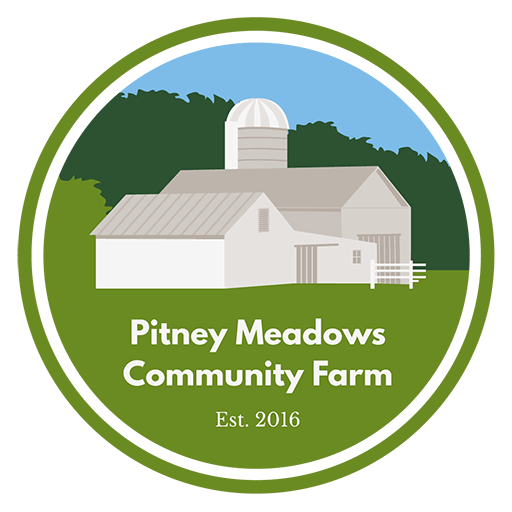Intern Project Spotlight: Unveiling the Secrets of Garden Ecosystems: A Summer Research Project by Camilla
 I am excited to share the culmination of a research project conducted over the summer of 2024 at Pitney Meadows Community Farm. As the Community Gardens intern this summer, I was given the unique opportunity to complete a project of my choice related to the Community Gardens. Combining my passion for gardening with my aspirations as a biologist, I chose to dive deeper into the interactions between plants and the insects they attract. From May through August, I observed and documented a diverse range of insect species across the gardens and fields, uncovering fascinating insights about our garden ecosystem.
I am excited to share the culmination of a research project conducted over the summer of 2024 at Pitney Meadows Community Farm. As the Community Gardens intern this summer, I was given the unique opportunity to complete a project of my choice related to the Community Gardens. Combining my passion for gardening with my aspirations as a biologist, I chose to dive deeper into the interactions between plants and the insects they attract. From May through August, I observed and documented a diverse range of insect species across the gardens and fields, uncovering fascinating insights about our garden ecosystem.
Why Understanding Plant-Insect Interactions Is Important
My research focused on identifying insects and which plants they frequented, revealing interesting patterns and relationships in the ecosystem at Pitney Meadows Community Farm. This study not only highlights which plants are most appealing to beneficial insects and pollinators, but also examines the role of pests – the insects who harm crops and native plants.
Understanding plant-insect interactions is crucial for various reasons. Many plants rely on insects for pollination, which is essential for their reproduction. By identifying which plants attract specific pollinators, gardeners can choose plants that enhance pollination rates, leading to more robust plant growth and increased fruit or seed production.
 While some insects are beneficial, others are considered pests that can harm crops and native plants. Understanding which plants attract pests allows gardeners to implement targeted strategies to manage these unwanted visitors. For instance, incorporating pest-repellent plants into your garden can be an effective strategy for managing pests. These plants use chemicals or physical structures to deter harmful insects. Nasturtium, for example, is known to repel squash bugs and aphids, and planting nasturtium near your crops or flowers can therefore offer protection from these pests. Additionally, adopting polyculture practices—growing a diverse mix of crops—can attract beneficial insects that help control pest populations and reduce reliance on chemical treatments.
While some insects are beneficial, others are considered pests that can harm crops and native plants. Understanding which plants attract pests allows gardeners to implement targeted strategies to manage these unwanted visitors. For instance, incorporating pest-repellent plants into your garden can be an effective strategy for managing pests. These plants use chemicals or physical structures to deter harmful insects. Nasturtium, for example, is known to repel squash bugs and aphids, and planting nasturtium near your crops or flowers can therefore offer protection from these pests. Additionally, adopting polyculture practices—growing a diverse mix of crops—can attract beneficial insects that help control pest populations and reduce reliance on chemical treatments.
It is important to note that pests have their part to play in this ecosystem too. They contribute to the delicate balance that supports beneficial insects by acting as their prey in many cases. Beneficial insects such as ladybugs, lacewings, and predatory beetles help control pest populations naturally. By fostering a garden environment that attracts these beneficial insects, gardeners can create a balanced ecosystem where natural pest control is enhanced.
 Project Insights + Findings
Project Insights + Findings
Throughout my summer project, I recorded observations of 111 insect species across the Community Gardens and crop lands, with 94 species being native to the United States. Notably, 75 of these species are either pollinators or beneficial insects. Approximately 35% of the recorded insects belong to the order Hymenoptera, which includes bees and wasps. Many bees and wasps contribute greatly to pollination or prey on pests like tomato hornworms. The plant attracting the highest number of species was common milkweed, hosting 19 different insect species. 81 of these insect species are featured in my “Plants and Their Insect Visitors” book, available in the Welcome Center or online . For a complete list of the recorded species and the plants they frequented, you can view it here.
Expanding the Research: The iNaturalist Project
A key objective of my project was to enhance our understanding of Pitney Meadows' biodiversity through the establishment of an iNaturalist account and project group. The Farm is home to a wide range of wildlife, from uncommon bird species to a variety of insects. This iNaturalist project aims to build a comprehensive record of the farm’s biodiversity and invites everyone to contribute.
To learn more about how to use iNaturalist, click here!
How iNaturalist Enhances Our Understanding:
- Document Species Diversity: Observations on iNaturalist help create a detailed record of species present on the farm. More observations provide a clearer picture of the farm's overall biodiversity.
- Foster Community Engagement: iNaturalist encourages public participation, turning observations into a collaborative effort. Involving visitors, gardeners, and local groups helps enrich our database and engage the community.
- Support Conservation Efforts: Data collected through iNaturalist informs conservation strategies and garden management practices. Understanding which species are thriving or struggling helps guide efforts to support and protect the farm’s wildlife.
Launched in May, the iNaturalist account has quickly become a valuable resource, thanks to contributions from first-time visitors and dedicated gardeners. By documenting various species, this collaborative effort significantly enriches our understanding of local wildlife populations in Saratoga Springs and aligns with the goals of my summer project.
Why This Matters for Your Garden
This research provides valuable insights into creating a vibrant and balanced garden ecosystem. By understanding plant-insect relationships, gardeners can attract more pollinators, manage pests effectively, and support beneficial insects. It’s about fostering a harmonious environment where every insect plays its part.
Whether you’re aiming to boost pollination, control pests, or enhance beneficial insect presence, the findings from this project offer practical advice to achieve your gardening goals. I hope this study inspires you to explore the intricate world of plant-insect interactions further and contribute to a more ecologically balanced world.
 Let’s continue to cultivate our passion for gardening and deepen our understanding of the natural world.
Let’s continue to cultivate our passion for gardening and deepen our understanding of the natural world.
For our younger explorers, I created a game of “Bug Bingo” that we encourage everyone to play! Trail-friendly “Bug Bingo” can be found in the Welcome Center, along with binoculars and magnifying glasses to aid in your explorations!
For our more experienced explorers, I created a “Field Guide”
Acknowledgements
I am deeply grateful to the team at Pitney Meadows Community Farm for their invaluable support. Special thanks to Melissa Spiegel, whose guidance and mentorship as my intern supervisor were crucial in shaping and completing this project. I also appreciate the support of Joyce Carroll and Cass Skarka, whose support was instrumental throughout this project.
Additionally, I want to thank Monica Raveret Richter. My previous classes and research with her at Skidmore College inspired me to pursue a project focused on insects and pollinators, and her expertise provided me with the essential tools and knowledge needed to succeed.
Finally, thank you to all gardeners who have participated in the Pitney Meadows iNaturalist, as you have all played a great part in this project.
 About Camilla, our 2024 Community Gardens Intern
About Camilla, our 2024 Community Gardens Intern
Camilla is a rising senior at Skidmore College building towards a degree in biology as well as environmental science and studies. As a biology major, she loves to be outdoors whenever she can be, whether it is through hiking and backpacking, walking her dog, or camping. She has always been involved and interested in gardening, starting out gardening with her mom when she was younger, and then working at other organizations, such as working with a tree planting group in Australia or interning at a sustainable flower farm. Camilla is excited to work at Pitney Meadows so she can gain more experience in gardening and build towards her future goal of becoming a conservation biologist.
